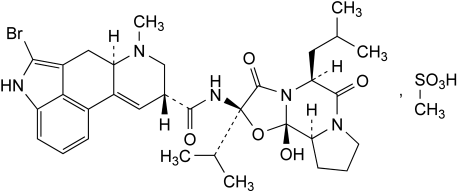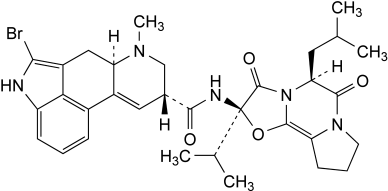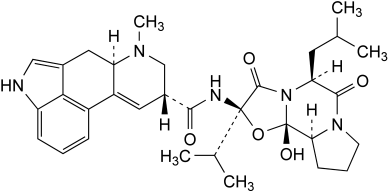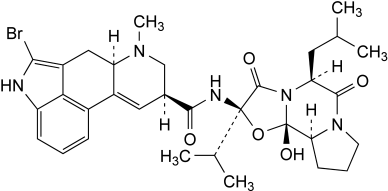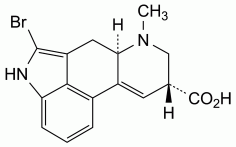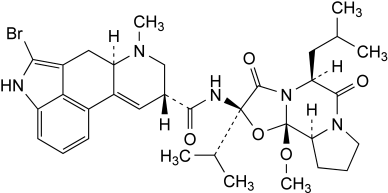Bromocriptine Mesilate
Action and use
Dopamine receptor agonist.
Preparations
Ph Eur
DEFINITION
(6aR,9R)-5-Bromo-N-[(2R,5S,10aS,10bS)-10b-hydroxy-2-(1-methylethyl)-5-(2-methylpropyl)-3,6-dioxooctahydro-8H-oxazolo[3,2-a]pyrrolo[2,1-c]pyrazin-2-yl]-7-methyl-4,6,6a,7,8,9-hexahydroindolo[4,3-fg]quinoline-9-carboxamide monomethanesulfonate.
Content
98.0 per cent to 101.0 per cent (dried substance).
PRODUCTION
It is considered that alkyl methanesulfonate esters are genotoxic and are potential impurities in bromocriptine mesilate. The manufacturing process should be developed taking into consideration the principles of quality risk management, together with considerations of the quality of starting materials, process capability and validation. The general methods 2.5.37. Methyl, ethyl and isopropyl methanesulfonate in methanesulfonic acid, 2.5.38. Methyl, ethyl and isopropyl methanesulfonate in active substances and 2.5.39. Methanesulfonyl chloride in methanesulfonic acid are available to assist manufacturers.
CHARACTERS
Appearance
White or slightly coloured, fine crystalline powder.
Solubility
Practically insoluble in water, freely soluble in methanol, soluble in ethanol (96 per cent), sparingly soluble in methylene chloride.
It is very sensitive to light.
The identification, tests and assay are to be carried out as rapidly as possible, protected from light.
IDENTIFICATION
First identification: B
Second identification: A, C, D, E
Test solution Dissolve 10.0 mg in 10 mL of methanol R and dilute to 200.0 mL with 0.01 M hydrochloric acid.
Spectral range 250-380 nm.
Absorption maximum At 305 nm.
Absorption minimum At 270 nm.
Specific absorbance at the absorption maximum 120 to 135 (dried substance).
Comparisonbromocriptine mesilate CRS.
Solvent mixtureethanol (96 per cent) R, methanol R, methylene chloride R (30:30:40 V/V/V).
Test solution Dissolve 10 mg of the substance to be examined in the solvent mixture and dilute to 10 mL with the solvent mixture.
Reference solution Dissolve 10 mg of bromocriptine mesilate CRS in the solvent mixture and dilute to 10 mL with the solvent mixture.
PlateTLC silica gel G plate R.
Mobile phaseconcentrated ammonia R, water R, 2-propanol R, methylene chloride R, ether R (0.1:1.5:3:88:100 V/V/V/V/V).
Application 10 µL.
Development Immediately in an unsaturated tank, over a path of 15 cm.
Drying In a current of cold air for 2 min.
Detection Spray with ammonium molybdate solution R3 and dry at 100 °C until the spots appear (about 10 min).
Results The principal spot in the chromatogram obtained with the test solution is similar in position, colour and size to the principal spot in the chromatogram obtained with the reference solution.
TESTS
Appearance of solution
The solution is clear (2.2.1) and not more intensely coloured than reference solution B5, BY5 or Y5 (2.2.2, Method II).
Dissolve 0.25 g in methanol R and dilute to 25 mL with the same solvent.
pH (2.2.3)
3.1 to 3.8.
Dissolve 0.2 g in a mixture of 2 volumes of methanol R and 8 volumes of carbon dioxide-free water R and dilute to 20 mL with the same mixture of solvents.
Specific optical rotation (2.2.7)
+ 95 to + 105 (dried substance).
Dissolve 0.100 g in a mixture of equal volumes of methanol R and methylene chloride R and dilute to 10.0 mL with the same mixture of solvents.
Related substances
Liquid chromatography (2.2.29).
Solvent mixturebuffer solution pH 2.0 R, methanol R (50:50 V/V).
Test solution Dissolve 0.500 g of the substance to be examined in 5.0 mL of methanol R and dilute to 10.0 mL with buffer solution pH 2.0 R.
Reference solution (a) Dilute 1.0 mL of the test solution to 100.0 mL with the solvent mixture.
Reference solution (b) Dilute 1.0 mL of reference solution (a) to 10.0 mL with the solvent mixture.
Reference solution (c) Dissolve the contents of a vial of bromocriptine mesilate for system suitability CRS (containing impurities A and B) in 1.0 mL of the solvent mixture.
Flow rate 2 mL/min.
Detection Spectrophotometer at 300 nm.
Injection 20 µL.
Identification of impurities Use the chromatogram supplied with bromocriptine mesilate for system suitability CRS and the chromatogram obtained with reference solution (c) to identify the peaks due to impurities A and B.
Relative retention With reference to bromocriptine: impurity C = about 1.2.
Loss on drying (2.2.32)
Maximum 3.0 per cent, determined on 0.500 g by drying in vacuo at 80 °C for 5 h.
ASSAY
Dissolve 0.500 g in 80 mL of a mixture of 10 volumes of anhydrous acetic acid R and 70 volumes of acetic anhydride R. Titrate with 0.1 M perchloric acid, determining the end-point potentiometrically (2.2.20).
1 mL of 0.1 M perchloric acid is equivalent to 75.1 mg of C33H44BrN5O8S.
STORAGE
In an airtight container, protected from light, at a temperature not exceeding -15 °C.
IMPURITIES
Specified impurities A, B, C, D, E, F, G
Ph Eur
